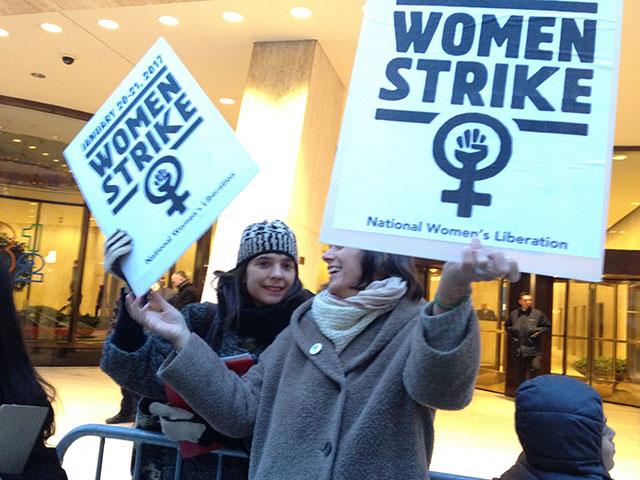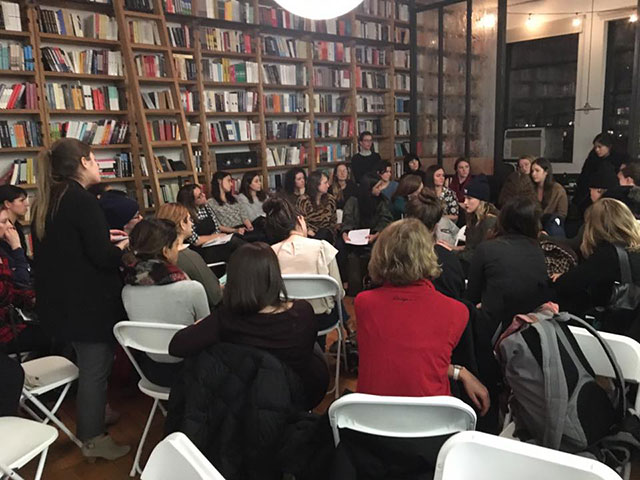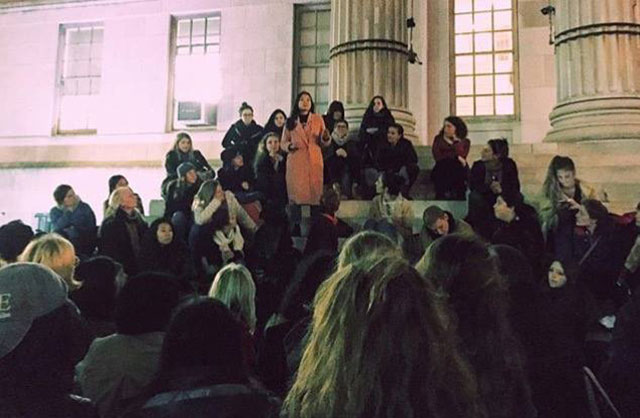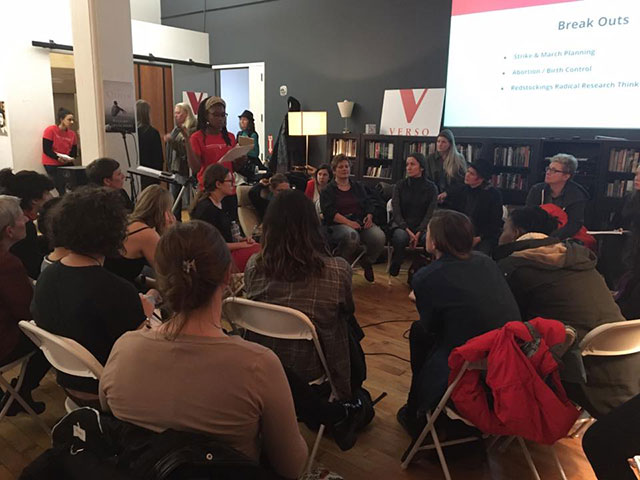
Part of the Series
The Struggle for Caregiving Equity
It can be easy to despair, to feel like trends toward inequality are impossible to stop, to give in to fear over increased racist, sexist and xenophobic violence. But around the country, people are doing the hard work of fighting back and coming together to plan for what comes next. In this ongoing “Interviews for Resistance” series, we introduce you to some of them. Today’s interview is the third in the series. Click here for the most recent interview before this one.
In this next installment of Interviews for Resistance, we speak with Erin Mahoney, union organizer and member of National Women’s Liberation, which is calling for a two-day women’s strike on January 20-21 to draw attention to the paid and unpaid work women do.
Sarah Jaffe: National Women’s Liberation has called for an interesting set of actions this weekend. Can you talk about the call for a women’s strike?
Erin Mahoney: We have called for a two-day women’s strike from January 20 to 21 to coincide with both the inauguration and the Women’s March. It is a strike of both paid and unpaid labor, to showcase how women do more than just participate in the workforce. We participate in many aspects of society that go unseen and really make both the home and the workplace run. It is a call to action for women to withhold both their paid and unpaid labor.
Talk a little bit about how you envision this going. What is the process for people to join the strike?
We wanted to make this a real action. We didn’t want it to be something that we just called for and hoped happened. So, we decided to add an aspect of women pledging to strike. We have a website (www.womenstrike.org) that was created after our November meeting. Women can go to that website and add their name and write a few sentences about what they are striking from and why they are striking.
We have got nearly five thousand signatures so far and they are coming in by the hundreds every day of women signing up to say that they will be striking from doing emotional labor in their household. They will be striking from their paying jobs. They will be striking from fake smiles, from making things run smoothly, from laundry to childcare, a whole host of different things that they are striking from. It is really moving to see the reasons why people are striking and also the breadth of work that they are striking from.
The history of calls for women to strike from unpaid work goes back to, among other things, the Wages for Housework movement. Can you talk about how this part of the strike came to be a key demand?
I think we were building upon what we have seen recently in other countries and also in our own country. In the US, in 1970, women called a strike for women’s equality on Women’s Equality Day, August 24, 1970, where 50,000 women across the country went on strike from their paid and unpaid jobs. I think it makes the point that we do a lot more than just paid labor in this country. In recent years, we have seen strikes in Iceland, in Argentina, in France and in Poland, where women have gone on strike for specific things. Like, in Poland, striking against the potential ban on abortion. They actually won that. In France and Iceland protesting the wage gap and walking off their jobs at the part of the day where they stopped being paid and men continue to get paid.
Women have used this tool in a variety of ways and it is really powerful. This strike comes out of women being so angry and upset that Donald Trump won this election and really thinking that we need to take bold action to show this administration that women are not going to sit by idly while they dismantle public programs and take us further back. Also, making sure we stay on the offense and that this doesn’t turn into a defensive battle. I think women are frustrated with where we are at right now. We basically have crumbs and we don’t want to fight like hell just to hold onto those crumbs. We want to be on the offense and make sure that we make advances for women. Advances that the Democrats could have made.
We need things like national free childcare, paid parental leave like they have in other countries. Two years in these other countries! A minimum $15 an hour for all women, no exceptions, all sectors of the workforce. We want to save Medicare and expand it to national healthcare and national childcare. We don’t want to be picking up the slack for programs that are being privatized by the Republicans. Oftentimes, when things are no longer universal, they are pushed back onto the family and that is code for women doing this work unpaid. I think a big part of this strike is showing that we know what our unpaid labor is and we are not doing any more of it and we are demanding advances so that we don’t have to do it anymore. These should be universal programs that corporations pay into and take off the backs of women.
 People take part in a pre-inauguration planning meeting organized by National Women’s Liberation at the Verso loft in Brooklyn, New York. (Photo: Erin Mahoney)
People take part in a pre-inauguration planning meeting organized by National Women’s Liberation at the Verso loft in Brooklyn, New York. (Photo: Erin Mahoney)
You went through some of the demands of the women’s strike, but what are some other things that are on the list?
There has been quite an array of things. People have talked about safety, just being able to walk down the street without having to worry about assaults. Other women have talked about not having to deal with street harassment. Fake smiles have been a demand, which had a lot of resonance, which I wasn’t expecting. It hit so close to home for so many women. An end to racism and bigotry of all sorts.
On our website, the testimonies are really beautiful, really deep parts of women’s lives, speaking openly, saying, “We are not going to take this anymore and we are joining the movement in droves.” That was another thing that really struck us — our November meeting was like a week after the election and we had hundreds and hundreds of women show up to what was a monthly meeting that normally has 50 people at it. We had nearly 800 women. So many that they couldn’t fit in our space and they were lined up around the block. From that, we really thought that we need to take bold action and in doing so, we just heard such a wide range of testimonies as to why women are getting involved in the movement. It has been a learning process for us, too, in terms of expanding our work and what the movement should be. It is giving women a direct voice to that which I think has been pretty incredible.
There have been debates within feminism in recent years about “Is the demand coming from below and valuing all women’s labor or is it about shattering the glass ceiling for women at the top?” Your demands seem to be coming from that kind of labor feminism angle.
I think if we look back [at] the history of the feminist movement and probably all sectors of the left, there are some places where the movement has been co-opted, I would say. I do think it is important to have equality in the workplace, but I think the feminist movement has had a pretty wide breadth. Just elements of it have been co-opted and taken within the corporate capitalist model. There are good parts of the book Lean In, but I wouldn’t call that necessarily coming from the feminist movement.
I do think that the feminist movement’s demands have always included national childcare. It was part of NOW, the National Organization for Women’s first demands, but it is not the demand that has gotten the most attention or perhaps the most traction in this country, because universal programs are so hard to fight for.
As part of this upsurge in participation in movements on the left right now, after this election of this horrible man, we’re going to be trying to sustain that, keeping people involved, and also making sure [these demands] are part of the movement that are the deepest. Make sure that the things we really need the most get the attention they should. I think we are starting to see that with the strike, putting women’s voices directly out there, which has been really great.
 At National Women’s Liberation’s November 15 general meeting in New York City, there were so many women, not all could fit in the space. So hundreds of women went to a nearby park and held a speak out to discuss building a movement against Trump and Pence, and building a strong women’s liberation movement. (Photo: Erin Mahoney)
At National Women’s Liberation’s November 15 general meeting in New York City, there were so many women, not all could fit in the space. So hundreds of women went to a nearby park and held a speak out to discuss building a movement against Trump and Pence, and building a strong women’s liberation movement. (Photo: Erin Mahoney)
On the website you do say something about [what] men’s involvement in the strike should be. Can you talk a little about that?
We have asked men to also pledge the strike and that means doing more around the house and more of the work that women typically do, so that women can be out there and strike and fully participate in this political activism. Instead of men necessarily walking off their paid jobs, maybe they are doing more of the work that their female partners are doing in the home, or that their sisters are doing to take care of their parents, or picking up the kids. Whatever that means. It is putting in extra work so that women can be out there for these two days.
As you say, part of the value of a strike is it frees up people’s time to do other things. How do you envision this strike interacting with the Women’s March and other actions that are planned for Inauguration Day?
We see it going hand in hand with that. Women are going to be out there at the march. My friends that haven’t been politically active for the time that I have known them, they have self-organized cars down to DC or to meet at spots in New York City for the march. My family in Minnesota is going out. My sisters are going out for the first time, which has been pretty incredible. We see the strike as really a way to add to that march. What work you are striking from as you go to the march or what demands do you have as you are marching in whatever city you are in?
We are having specific meet up spots where women have pledged to strike. But anywhere, wherever people are in the country and signed up to strike, we encourage people to go out to the march and march with other women as they are striking from their work.
Obviously, if you are gathering pledges from people, you are gathering contact information. Where do you see this going and is it a way to help build a national organization that can then, again, take strike action or other actions when, for instance, Congress is voting on taking away healthcare or something like that?
Yes, definitely. It is a way for us to gather contact info, get women’s input and get their action and activism going; also to be able to continue to fight for these demands. It is not something that is going to happen in two days. This is a strong, bold action. We are sending a message [about] what women are willing to do and how far they are willing to go on Day One of this administration. But, it is going to take a lot more work, a lot more meetings, a lot more activism in between meetings, and building to really win the things that we need to be free.
This is building that in an organized way. Having contact information, having meetings in local cities, starting to build real movement, and making this long-lasting and persistent so that the energy that we have right now doesn’t fade as we go into several months after this. We are planning immediately after the strike, just in concrete terms, to survey women about how it went and find out what parts of the organization they might want to get involved in afterwards, which one of the demands called to them and how they want to participate in that.
 People take part in a pre-inauguration planning meeting organized by National Women’s Liberation at the Verso loft in Brooklyn, New York. (Photo: Erin Mahoney)
People take part in a pre-inauguration planning meeting organized by National Women’s Liberation at the Verso loft in Brooklyn, New York. (Photo: Erin Mahoney)
Your day job is in the labor movement. Has there been interest in this strike from organized labor? From groups within organized labor? Any outreach on that front?
It is interesting that several of the women who are organizing the strike are also union organizers. I do think we have taken some of the lessons from our paid work and put into the feminist movements. In that way, I do think the labor movement is working with us and has been adding to the feminist movement. We haven’t had unions necessarily sign on or send out the strike pledge. But, we have definitely had a lot of women speak about their union activism as they pledge to strike.
I think the consciousness is affecting the militancy. On our strike website and in our meetings we have talked about how women at Walmart, women in the fast food industry have been striking for years and taking bold action and the impact that it has had on their working conditions and on the entire country in terms of raising the minimum wage and raising their consciousness. I think it has had impact on us even calling the strike.
Hopefully, what we are striking from — like this unpaid work that we are talking about, all of the things we do to pick up the slack — and what we are striking for, like paid parental leave, universal healthcare, have an impact on the labor movement and what they are fighting for. I do think that the feminist movement and the labor movement need to be working together in a closer way. Also, hopefully, raising the consciousness of women that are in unions and that are starting to be organized into unions will have an effect on the demands that are being brought to the table, or what unions are fighting for politically. It needs to go into the homes, as well, and a lot of the unpaid work and slack that we pick up as women.
It is interesting because this election season revolved around jobs, but it revolved around, many times, certain kinds of jobs. It revolved around factory jobs at the Carrier plant or things like that. The idea that jobs have been outsourced. Whereas, this strike is sort of forcing attention back on work that is very hard to outsource. A lot of the work women do, you can’t send it to China.
You can’t send it to China and society wouldn’t run if it wasn’t being done. It is the invisible work of “What happens at three o’clock when school is over?” Women are the ones going in and out of the workforce and not getting raises and not getting promoted or maybe losing their jobs because they have to [take care of children]. That is work, real work, that we are doing to make society run, to raise the next generation of people that will be in the workforce, that will be working at the post office, working at the local store, or running whatever workplace is next, that the real work that makes our society run is raising those kids. So, the fact that [it] isn’t being seen as a contribution to society and something that society should pay into, is something that needs to change. That is work that we need to start looking at and start looking at in a way that the labor movement has an impact on.
I remember seeing a Donald Trump ad with Ivanka Trump saying that Donald Trump was going to give us paid family leave. Some of these ideas are out there to the point where Donald Trump felt the need to try to co-opt them. What do you think the odds are for actually pushing for some of these things even under a Trump administration?
I have no reason to think that any of this will be any easier under a Trump administration. I think that it is exactly what you are saying, a co-option of what we have been calling for. The fact that we have made these ideas so popular and also that people are at a breaking point, not just in the US, but all across the world. I think that is why we are seeing this rise in populism and people demanding a real change and break from what we normally see.
I think it is going to be harder, much harder, to fight under Trump. It is going to be a real battle, but I don’t think that means that we should stop fighting. I think that we could raise a lot of consciousness, put a lot of women in the street, a lot of people in the street. I hope that we can change what our movements are fighting for and fight in a deeper, broader way that will go beyond just the next election cycle.
I do think that we need to build an independent movement that is not focused solely on electing the next Democrat, but is focused on building a movement that the elected officials really feel accountable to, no matter what party they are in. I think it is going to be harder to do under a Trump administration, because I think there is going to be a lot of repression. But, I think what we are seeing, in terms of this upswell of people being involved, is one bright side. I think if we can really grab onto that and get people involved in a long-term, persistent way that has political education and is participatory and gets people involved in ways that can make something big and something real [so] that we can win these programs — I do have hope in that way.
Anything else people should know about the women’s strike?
You can sign up to strike at www.womenstrike.org. We are still collecting pledges and we hope that folks sign up to strike and list what you are striking from and add to our list of demands and get involved locally in your Women’s March.
Interviews for Resistance is a project of Sarah Jaffe, with assistance from Laura Feuillebois and support from the Nation Institute. It is also available as a podcast. Truthout has lightly edited this article for ease of reading.
We’re not backing down in the face of Trump’s threats.
As Donald Trump is inaugurated a second time, independent media organizations are faced with urgent mandates: Tell the truth more loudly than ever before. Do that work even as our standard modes of distribution (such as social media platforms) are being manipulated and curtailed by forces of fascist repression and ruthless capitalism. Do that work even as journalism and journalists face targeted attacks, including from the government itself. And do that work in community, never forgetting that we’re not shouting into a faceless void – we’re reaching out to real people amid a life-threatening political climate.
Our task is formidable, and it requires us to ground ourselves in our principles, remind ourselves of our utility, dig in and commit.
As a dizzying number of corporate news organizations – either through need or greed – rush to implement new ways to further monetize their content, and others acquiesce to Trump’s wishes, now is a time for movement media-makers to double down on community-first models.
At Truthout, we are reaffirming our commitments on this front: We won’t run ads or have a paywall because we believe that everyone should have access to information, and that access should exist without barriers and free of distractions from craven corporate interests. We recognize the implications for democracy when information-seekers click a link only to find the article trapped behind a paywall or buried on a page with dozens of invasive ads. The laws of capitalism dictate an unending increase in monetization, and much of the media simply follows those laws. Truthout and many of our peers are dedicating ourselves to following other paths – a commitment which feels vital in a moment when corporations are evermore overtly embedded in government.
Over 80 percent of Truthout‘s funding comes from small individual donations from our community of readers, and the remaining 20 percent comes from a handful of social justice-oriented foundations. Over a third of our total budget is supported by recurring monthly donors, many of whom give because they want to help us keep Truthout barrier-free for everyone.
You can help by giving today. Whether you can make a small monthly donation or a larger gift, Truthout only works with your support.